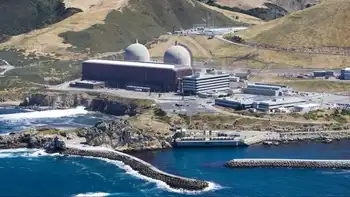Firm seeks to power Abitibi mill and province
ONTARIO - Newsprint giant Abitibi Consolidated Inc., which partly blames volatile energy prices for the closing of two of its Canadian paper mills over the past year, is hoping that a $250 million co-generation project with Northland Power Inc. will save its Thorold mill from a similar fate.
Northland, a Toronto-based power producer, has plans to develop a high-efficiency, 250-megawatt natural gas plant that would supply up to 45 megawatts under long-term contract directly to Abitibi's mill and feed the rest to the provincial grid.
The mill's newsprint recycling operation would also use steam produced by waste heat at the neighbouring plant about five kilometres south of St. Catharines.
Sam Mantenuto, chief operating officer of Northland, calls the project a "jewel." He says it takes pressure off the Ontario grid, provides a struggling pulp and paper company with stable energy prices, and secures 400 jobs in Thorold.
It would also offset dirty coal from the nearby Nanticoke generation station, which the government plans to shut down in 2009, with a much more efficient and cleaner alternative.
"It has all the elements," says Mantenuto. "This is... one of the top two or three projects in this province."
Robin Brock, mayor of Thorold, calls the project a "wonderful thing" for the community, while one Abitibi spokesperson says it would protect the mill from the "gyrations" of Ontario's energy market.
But before the project can move forward, there's one major hitch: Northland must convince the Ontario Power Authority to purchase the excess energy under a long-term agreement at a decent enough rate to attract investors.
Without a commitment from the province and the certainty that comes with it, Northland has little hope of attracting the necessary financing.
Last June, the Ministry of Energy ordered the power authority to launch a process that would lead to the development of up to 1,000 megawatts of combined heat and power or "co-generation" projects across Ontario.
The deadline for registration is today. All bids must be submitted by July 12, and the government is expected to pick the "winners" later in the summer after thorough evaluation.
Mantenuto says the government deserves credit for seeking out such projects, but he's concerned that the 1,000-megawatt cap, which could limit the final selection to two or three bidders, could be restrictive enough to bump Northland's proposal out of the running.
His biggest concern is that the power authority will lump projects together in the same box and evaluate oranges and apples using the same criteria: whatever offers the cheapest price per kilowatt-hour.
For example, natural gas projects must compete against waste gas projects, the latter having the economic advantage because the fuel is essentially free once it's captured.
"I'm having to compete against a project that might come from a steel mill that's using free fuel," says Mantenuto. "Why the hell am I competing against a steel mill? They've got a fundamentally different process than I do."
Jack Gibbons, chair of the Ontario Clean Air Alliance, finds the cap and the evaluation process equally baffling. He says a Ministry of Energy study concluded six years ago that the province had a combined heat and power potential of over 16,000 megawatts.
"The 1,000 megawatt cap is very unfortunate. The OPA should purchase all the combined heat and power that's offered to it that is lower cost than new nuclear supply. "If they pursued all the cost-effective combined heat and power, they could totally eliminate the need for new nuclear power plants and replace all our existing nuclear capacity by 2020. So there's a tremendous opportunity there."
The OPA is aware of the concern. Paul Bradley, vice-president of generation development, admits the authority is looking to buy the cheapest power it can get and doesn't give as much weight to the heat output of a plant or other benefits to industry.
Bradley adds that the 1,000-megawatt cap is merely a starting point, and that after this first round the power authority will likely go back to the market seeking deals for other industrial co-generation projects.
"We could ask the ministry to expand it and take some of the projects that don't win, or we could say, `Maybe there were some folks in there that weren't ready for prime time', and we could do (another) one a year from now."
That's little comfort for Mantenuto. For this upcoming bidding, he says Northland has already spent more than $2 million getting permits and doing pre-planning for engineering and construction.
Abitibi can't wait much longer. Its Thorold mill, which dates back to 1913, is using vintage boilers from the 1940s to provide steam. "They're old, old boilers," says spokesperson Marc Macdonald. "Abitibi... can't wait anymore," says Mantenuto. "People need to move on and make decisions now."
Related News

Mercury in $3 billion takeover bid for Tilt Renewables
SYDNEY - Mercury Energy and an Australian partner appear to have won the race to buy Tilt Renewables, an Australasian wind farm developer which was spun out of TrustPower, bidding almost $3 billion.
Yesterday Tilt Renewables announced that it had entered a scheme implementation agreement under which it was proposed that PowAR would acquire its Australian business and Mercury would acquire the New Zealand business.
Conducted through a scheme of arrangement, Tilt shareholders will be offered $7.80 a share, valuing Tilt at $2.96b.
Yesterday morning shares in Tilt opened about 18 per cent up at $7.65.
In early December Infratil, which owns around two…




